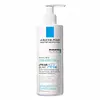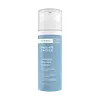What's inside
What's inside
 Key Ingredients
Key Ingredients

 Benefits
Benefits

 Concerns
Concerns

 Ingredients Side-by-side
Ingredients Side-by-side

Water
Skin ConditioningButyrospermum Parkii Butter
Skin ConditioningGlycerin
HumectantDimethicone
EmollientNiacinamide
SmoothingCetearyl Alcohol
EmollientBrassica Campestris Seed Oil
Skin ConditioningGlyceryl Stearate
EmollientAmmonium Polyacryloyldimethyl Taurate
Emulsion StabilisingPEG-100 Stearate
Propanediol
SolventOphiopogon Japonicus Root Extract
Skin ConditioningPEG-20 Methyl Glucose Sesquistearate
EmulsifyingSorbitan Tristearate
EmulsifyingDimethiconol
EmollientSodium Chloride
MaskingMannose
HumectantCoco-Betaine
CleansingDisodium EDTA
Capryloyl Glycine
CleansingCaprylyl Glycol
EmollientVitreoscilla Ferment
Skin ConditioningCitric Acid
BufferingMaltodextrin
AbsorbentXanthan Gum
EmulsifyingTocopherol
AntioxidantPentaerythrityl Tetra-Di-T-Butyl Hydroxyhydrocinnamate
AntioxidantWater, Butyrospermum Parkii Butter, Glycerin, Dimethicone, Niacinamide, Cetearyl Alcohol, Brassica Campestris Seed Oil, Glyceryl Stearate, Ammonium Polyacryloyldimethyl Taurate, PEG-100 Stearate, Propanediol, Ophiopogon Japonicus Root Extract, PEG-20 Methyl Glucose Sesquistearate, Sorbitan Tristearate, Dimethiconol, Sodium Chloride, Mannose, Coco-Betaine, Disodium EDTA, Capryloyl Glycine, Caprylyl Glycol, Vitreoscilla Ferment, Citric Acid, Maltodextrin, Xanthan Gum, Tocopherol, Pentaerythrityl Tetra-Di-T-Butyl Hydroxyhydrocinnamate
Water
Skin ConditioningCyclopentasiloxane
EmollientOctyldodecyl Neopentanoate
EmollientVinyl Dimethicone/Methicone Silsesquioxane Crosspolymer
Glycerin
HumectantSodium Ascorbyl Phosphate
AntioxidantCetyl Alcohol
EmollientNiacinamide
SmoothingDimethicone
EmollientCetearyl Alcohol
EmollientButylene Glycol
HumectantGlyceryl Stearate
EmollientPEG-100 Stearate
Adenosine
Skin ConditioningEpigallocatechin Gallate
AntioxidantGlucose Oxidase
StabilisingLactoperoxidase
StabilisingBoerhavia Diffusa Root Extract
Skin ProtectingCocos Nucifera Fruit Extract
EmollientLactobacillus
Skin ConditioningPolysilicone-11
Sodium Chloride
MaskingPotassium Thiocyanate
StabilisingGlucose
HumectantXanthan Gum
EmulsifyingCeteareth-20
CleansingDecyl Glucoside
CleansingCitric Acid
BufferingPhenoxyethanol
PreservativeWater, Cyclopentasiloxane, Octyldodecyl Neopentanoate, Vinyl Dimethicone/Methicone Silsesquioxane Crosspolymer, Glycerin, Sodium Ascorbyl Phosphate, Cetyl Alcohol, Niacinamide, Dimethicone, Cetearyl Alcohol, Butylene Glycol, Glyceryl Stearate, PEG-100 Stearate, Adenosine, Epigallocatechin Gallate, Glucose Oxidase, Lactoperoxidase, Boerhavia Diffusa Root Extract, Cocos Nucifera Fruit Extract, Lactobacillus, Polysilicone-11, Sodium Chloride, Potassium Thiocyanate, Glucose, Xanthan Gum, Ceteareth-20, Decyl Glucoside, Citric Acid, Phenoxyethanol
 Reviews
Reviews

Ingredients Explained
These ingredients are found in both products.
Ingredients higher up in an ingredient list are typically present in a larger amount.
Cetearyl alcohol is a mixture of two fatty alcohols: cetyl alcohol and stearyl alcohol. It is mainly used as an emulsifier. Emulsifiers help prevent the separation of oils and products. Due to its composition, it can also be used to thicken a product or help create foam.
Cetearyl alcohol is an emollient. Emollients help soothe and hydrate the skin by trapping moisture.
Studies show Cetearyl alcohol is non-toxic and non-irritating. The FDA allows products labeled "alcohol-free" to have fatty alcohols.
This ingredient is usually derived from plant oils such as palm, vegetable, or coconut oils. There is debate on whether this ingredient will cause acne.
Due to the fatty acid base, this ingredient may not be Malassezia folliculitis safe.
Learn more about Cetearyl AlcoholCitric Acid is an alpha hydroxy acid (AHA) naturally found in citrus fruits like oranges, lemons, and limes.
Like other AHAs, citric acid can exfoliate skin by breaking down the bonds that hold dead skin cells together. This helps reveal smoother and brighter skin underneath.
However, this exfoliating effect only happens at high concentrations (20%) which can be hard to find in cosmetic products.
Due to this, citric acid is usually included in small amounts as a pH adjuster. This helps keep products slightly more acidic and compatible with skin's natural pH.
In skincare formulas, citric acid can:
While it can provide some skin benefits, research shows lactic acid and glycolic acid are generally more effective and less irritating exfoliants.
Most citric acid used in skincare today is made by fermenting sugars (usually from molasses). This synthetic version is identical to the natural citrus form but easier to stabilize and use in formulations.
Read more about some other popular AHA's here:
Learn more about Citric AcidDimethicone is a type of synthetic silicone created from natural materials such as quartz.
What it does:
Dimethicone comes in different viscosities:
Depending on the viscosity, dimethicone has different properties.
Ingredients lists don't always show which type is used, so we recommend reaching out to the brand if you have questions about the viscosity.
This ingredient is unlikely to cause irritation because it does not get absorbed into skin. However, people with silicone allergies should be careful about using this ingredient.
Note: Dimethicone may contribute to pilling. This is because it is not oil or water soluble, so pilling may occur when layered with products. When mixed with heavy oils in a formula, the outcome is also quite greasy.
Learn more about DimethiconeGlycerin is already naturally found in your skin. It helps moisturize and protect your skin.
A study from 2016 found glycerin to be more effective as a humectant than AHAs and hyaluronic acid.
As a humectant, it helps the skin stay hydrated by pulling moisture to your skin. The low molecular weight of glycerin allows it to pull moisture into the deeper layers of your skin.
Hydrated skin improves your skin barrier; Your skin barrier helps protect against irritants and bacteria.
Glycerin has also been found to have antimicrobial and antiviral properties. Due to these properties, glycerin is often used in wound and burn treatments.
In cosmetics, glycerin is usually derived from plants such as soybean or palm. However, it can also be sourced from animals, such as tallow or animal fat.
This ingredient is organic, colorless, odorless, and non-toxic.
Glycerin is the name for this ingredient in American English. British English uses Glycerol/Glycerine.
Learn more about GlycerinGlyceryl Stearate is a mix of glycerin and stearic acid.
It is used to stabilize the mixing of water and oil ingredients. By preventing these ingredients from separating, it can help elongate shelf life. It can also help thicken the product's texture.
As an emollient, it helps soften skin and supports barrier-replenishing ingredients.
In cosmetics, Glyceryl Stearate is often made from vegetable oils or synthetically produced.
This ingredient may not be fungal-acne safe
Fun fact: The human body also creates Glyceryl Stearate naturally.
Learn more about Glyceryl StearateNiacinamide is a multitasking form of vitamin B3 that strengthens the skin barrier, reduces pores and dark spots, regulates oil, and improves signs of aging.
And the best part? It's gentle and well-tolerated by most skin types, including sensitive and reactive skin.
You might have heard of "niacin flush", or the reddening of skin that causes itchiness. Niacinamide has not been found to cause this.
In very rare cases, some individuals may not be able to tolerate niacinamide at all or experience an allergic reaction to it.
If you are experiencing flaking, irritation, and dryness with this ingredient, be sure to double check all your products as this ingredient can be found in all categories of skincare.
When incorporating niacinamide into your routine, look out for concentration amounts. Typically, 5% niacinamide provides benefits such as fading dark spots. However, if you have sensitive skin, it is better to begin with a smaller concentration.
When you apply niacinamide to your skin, your body converts it into nicotinamide adenine dinucleotide (NAD). NAD is an essential coenzyme that is already found in your cells as "fuel" and powers countless biological processes.
In your skin, NAD helps repair cell damage, produce new healthy cells, support collagen production, strengthen the skin barrier, and fight environmental stressors (like UV and pollution).
Our natural NAD levels start to decline with age, leading to slower skin repair, visible aging, and a weaker skin barrier. By providing your skin niacinamide, you're recharging your skin's NAD levels. This leads to stronger, healthier, and younger looking skin.
Another name for vitamin B3 is nicotinamide. This vitamin is water-soluble and our bodies don't store it. We obtain Vitamin B3 from either food or skincare. Meat, fish, wheat, yeast, and leafy greens contain vitamin B3.
The type of niacinamide used in skincare is synthetically created.
Learn more about NiacinamidePeg-100 Stearate is an emollient and emulsifier. As an emollient, it helps keep skin soft by trapping moisture in. On the other hand, emulsifiers help prevent oil and water from separating in a product.
PEGS are a hydrophilic polyether compound . There are 100 ethylene oxide monomers in Peg-100 Stearate. Peg-100 Stearate is polyethylene glycol ester of stearic acid.
Chances are, you eat sodium chloride every day. Sodium Chloride is also known as table salt.
This ingredient has many purposes in skincare: thickener, emulsifier, and exfoliator.
You'll most likely find this ingredient in cleansers where it is used to create a gel-like texture. As an emulsifier, it also prevents ingredients from separating.
There is much debate on whether this ingredient is comedogenic. The short answer - comedogenic ratings don't tell the whole story. Learn more about comegodenic ratings here.
The concensus about this ingredient causing acne seems to be divided. Research is needed to understand if this ingredient does cause acne.
Scrubs may use salt as the primary exfoliating ingredient.
Learn more about Sodium ChlorideWater. It's the most common cosmetic ingredient of all. You'll usually see it at the top of ingredient lists, meaning that it makes up the largest part of the product.
So why is it so popular? Water most often acts as a solvent - this means that it helps dissolve other ingredients into the formulation.
You'll also recognize water as that liquid we all need to stay alive. If you see this, drink a glass of water. Stay hydrated!
Learn more about WaterXanthan gum is used as a stabilizer and thickener within cosmetic products. It helps give products a sticky, thick feeling - preventing them from being too runny.
On the technical side of things, xanthan gum is a polysaccharide - a combination consisting of multiple sugar molecules bonded together.
Xanthan gum is a pretty common and great ingredient. It is a natural, non-toxic, non-irritating ingredient that is also commonly used in food products.
Learn more about Xanthan Gum